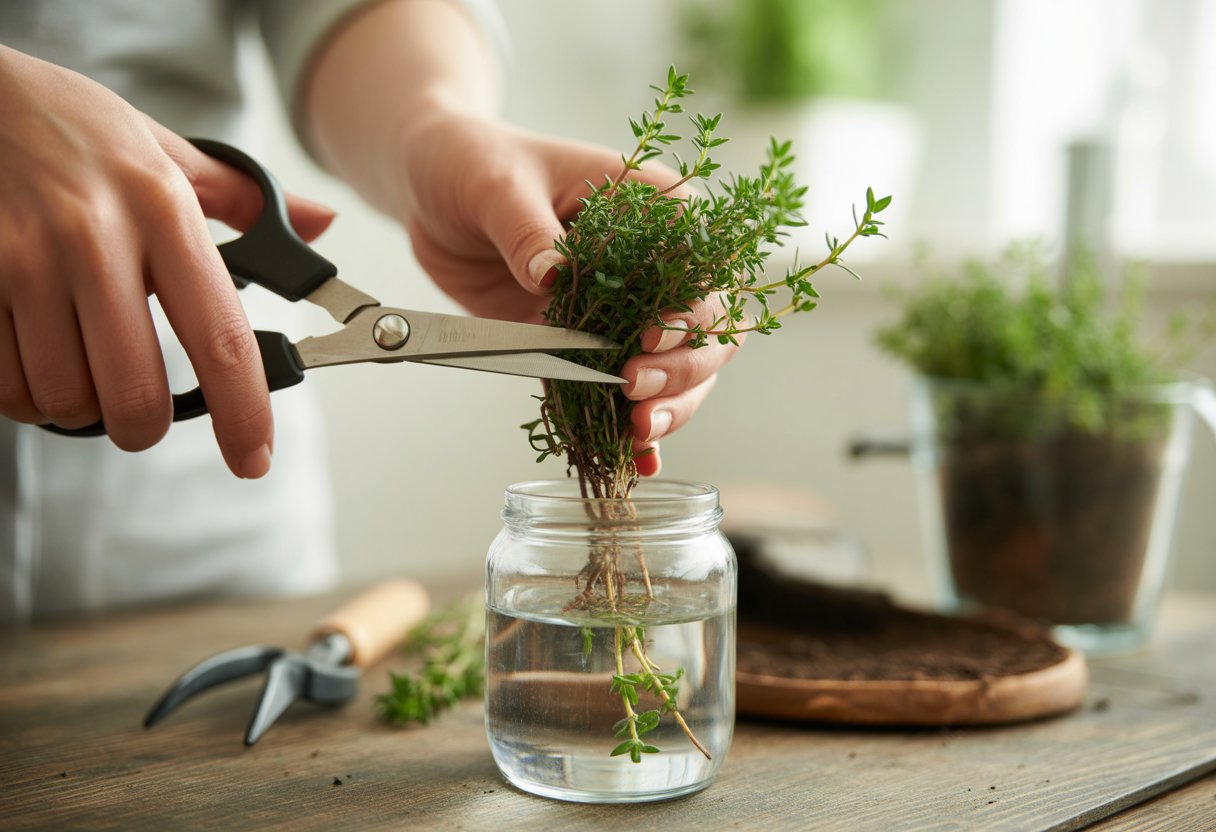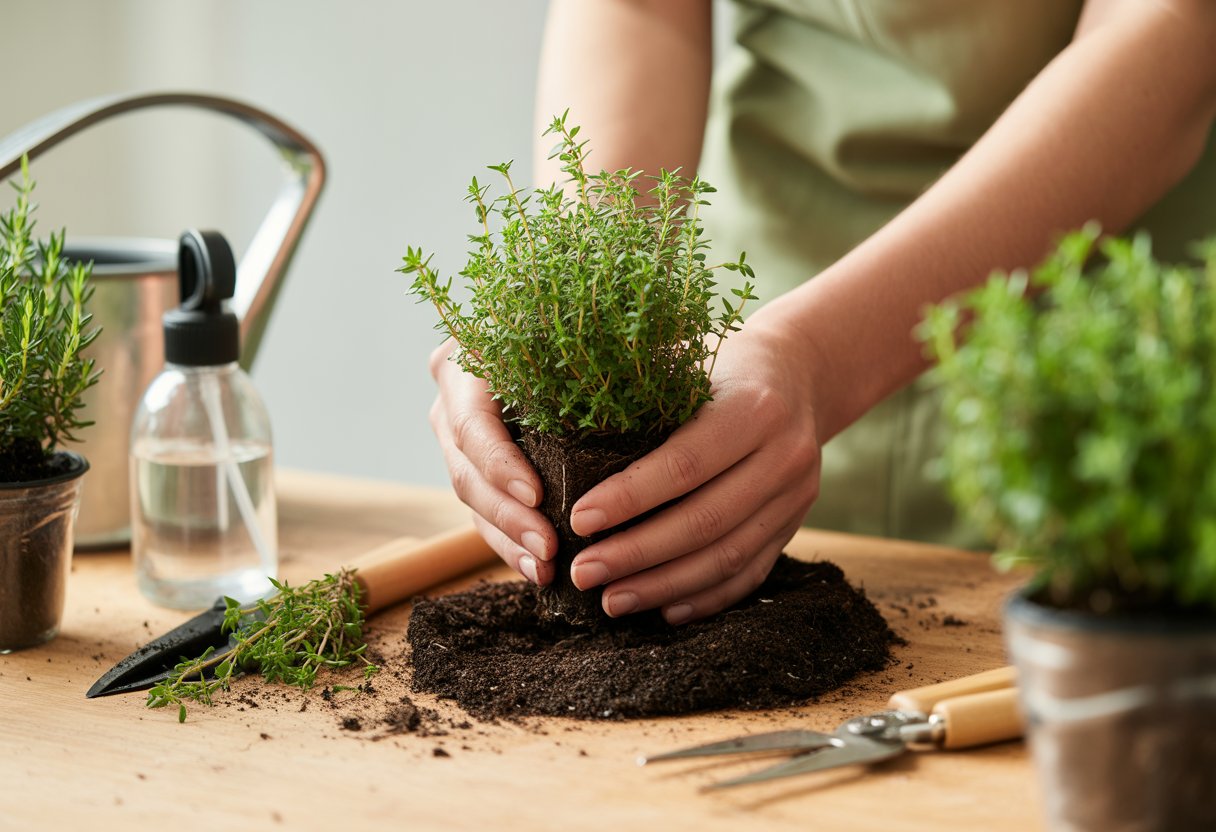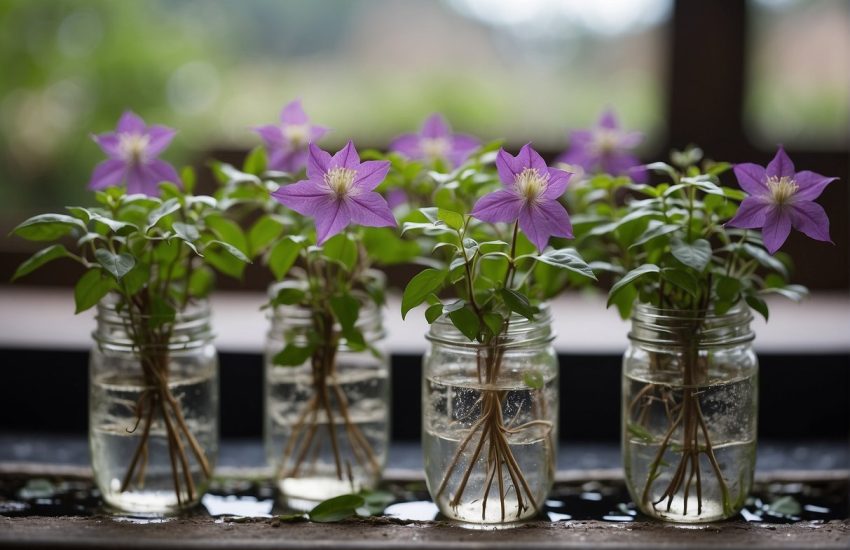How to Propagate Thyme Effectively for a Thriving Herb Garden
Propagating thyme is actually pretty easy, and it’s a great way to expand your herb garden without spending more money. The simplest way? Just take some stem cuttings, pop them in water or soil, and wait for roots to show up before you move them.
This method keeps your new plants healthy and lets you keep the same qualities as the parent thyme.

Thyme’s a tough little herb and it usually responds well to propagation, so it’s not intimidating even if you’re new to gardening. If you get the basics down, you can grow new thyme plants at home without much fuss.
Choosing the Right Variety and Preparing for Propagation
Picking the right thyme variety and setting up a good growing environment really matters. You’ll want to know what your chosen plant likes, and get your soil and containers ready before you start.
Selecting Thyme Types for Propagation
There are a bunch of thyme types in the Thymus genus, and not all are created equal. For cooking, most folks go with common thyme (Thymus vulgaris) or lemon thyme (Thymus citriodorus) because of their flavor. Creeping thyme, like T. praecox, is more for ground cover or just looking pretty.
Some types handle cold better than others. T. praecox is tougher in chilly weather, while lemon thyme likes it mild. If you’re taking cuttings, skip the woody stems—young, soft ones root way easier.
Understanding Ideal Growing Conditions
Thyme loves full sun—at least 6 hours a day, honestly, more is better. You’ve got to have well-drained soil or you’ll risk root rot, since thyme hates soggy feet.
The soil should stay a bit moist but never waterlogged. Aim for a pH between 6.0 and 8.0 if you’re feeling precise. These conditions help thyme grow thick, fragrant leaves, just like it does in the Mediterranean.
Preparing Soil and Containers
Go for a light, well-draining soil mix. Mixing potting soil, sand, and perlite in equal parts works well and keeps air moving around the roots. Steer clear of heavy garden soil that holds too much water.
You’ll need containers with drainage holes—don’t skip this. Wide, shallow pots are best because thyme roots don’t go very deep. Give your pots a quick wash or sterilize them to avoid fungus sneaking in.
Lightly moisten the soil before planting, but don’t make it soggy. This helps roots start out strong and keeps fungal issues at bay.
Propagation Methods for Thyme
You can propagate thyme by seeds, cuttings, or division. Each one has its own quirks and timing.
Growing Thyme from Seed
If you’re starting from seed, sow them in a well-draining mix indoors. The seeds are tiny—just press them into the surface or barely cover them.
They usually sprout in 1 to 2 weeks if you keep things around 65-70°F (18-21°C). Keep the soil damp but not soaked.
Once the seedlings have 4-6 true leaves, move them to their own pots or outside after frost is gone. Growing from seed takes patience, but you’ll get a lot of plants.
How to Propagate Thyme from Cuttings
Snip young, healthy stems about 3-4 inches long from your thyme plant. Pull off the leaves on the bottom half.
Dip the cut end in rooting hormone if you have it. Stick the cutting in a pot with moist, well-draining soil or a soilless mix.
Set the pot somewhere warm with indirect light. Roots should show up in 2-4 weeks. Keep the soil moist, but don’t drown it.
Once you see roots, transplant the cuttings to bigger pots or out into your garden.
Dividing Established Thyme Plants
Divide thyme in early spring or fall, when it’s not blooming. Gently dig up the plant.
Use a sharp knife or just your hands to split the root ball into smaller chunks. Make sure each piece has some roots and stems.
Replant the divisions right away in prepared soil. Water them well so they settle in. Dividing is a nice way to refresh older thyme and get more plants fast.
Caring for New Thyme Plants After Propagation

New thyme plants need some attention so they can put down roots and grow strong. Light, water, and a bit of patience go a long way.
Sunlight and Watering Requirements
Thyme wants full sun—give new plants at least 6 hours a day to keep them sturdy and prevent them from getting leggy. If they don’t get enough light, they’ll stretch out and look weak.
Water moderately. Keep the soil evenly moist, but don’t let it get soggy. Too much water can cause root rot, especially in young plants. Water when the top inch of soil feels dry. Good drainage is key.
Transplanting Seedlings and Rooted Cuttings
When seedlings or cuttings have a decent root system—usually after 4-6 weeks—move them to bigger pots or into the garden. Use well-draining soil with a sandy or loamy texture to avoid soggy roots.
Space the plants about a foot apart for airflow. Handle them gently; their roots are delicate. Wait until after the last frost if you’re planting outside, just to be safe.
Pruning and Encouraging Healthy Growth
Pruning makes thyme grow bushier and stops it from getting woody. Once your plant’s settled in, just cut back the tops now and then to spark new shoots.
You’ll get more leaves this way, too. If you want more leaves instead of seeds, snip off any flowering stems early.
Try not to prune heavily late in the season—it can really stress the plant. Regular trimming keeps thyme lively and productive.


